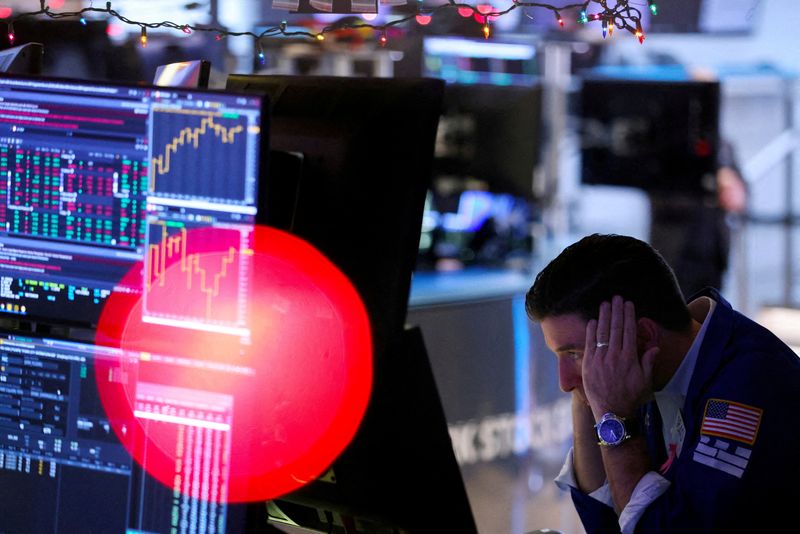Investing.com — U.S. stocks fell Thursday, weighed by disappointment from technology giants Meta (NASDAQ:META) and Microsoft (NASDAQ:MSFT) as well as widely-watched inflation data.
By 09:45 ET (13:45 GMT), the Dow Jones Industrial Average was down 255 points, or 0.6%, the S&P 500 index fell 62 points, or 1.1%, and the NASDAQ Composite dropped 330 points, or 1.8%.
Microsoft, Meta fall on increased expenses outlook
Tech giants Meta and Microsoft both traded lower Thursday, even as their earnings for the September quarter beat expectations.
Both firms forecast increased expenses on artificial intelligence in the coming quarters, while also missing expectations on other key metrics.
Microsoft forecast slower-than-expected cloud business growth in the current quarter while clocking much higher expenses, especially on AI.
Meta warned of a sharp increase in AI-related spending in the coming year, while user growth was at a slower pace in the September quarter than the prior one.
The showings provided mixed cues to investors about just how much of an earnings driver AI was going to be, especially considering the copious amount of capital expenditure on the technology.
They also largely offset positive cues from Goole parent Alphabet (NASDAQ:GOOGL), which clocked strong growth in its quarterly cloud revenue but did not warn of a drastic increase in costs.
The mixed showings from Meta and Microsoft now put investors on guard over upcoming prints from Apple (NASDAQ:AAPL) and Amazon (NASDAQ:AMZN), which are due on Thursday.
Beyond the megacap tech earnings, weak showings from some chip stocks – namely AMD (NASDAQ:AMD) and Qorvo (NASDAQ:QRVO) – also weighed on overall sentiment.
Quarterly earnings continue
There were more earnings to digest Thursday, as the results season continued apace.
eBay (NASDAQ:EBAY) stock fell 9% after the ecommerce firm reported disappointing guidance for the crucial holiday shopping season.
Robinhood (NASDAQ:HOOD) stock slumped 12% after the trading platform reported that its third-quarter earnings missed expectations, although crypto trading volume and revenue doubled year-on-year.
Uber Technologies (NYSE:UBER) stock fell 8% after the ride-hailing firm’s gross bookings grew at its slowest pace in over a year, even as it edged past quarterly profit estimates.
Estee Lauder (NYSE:EL) stock slumped 25% after the cosmetics giant reported a revenue miss and withdrew its fiscal 2025 outlook amid ongoing challenges in China and travel retail.
Fed to meet next week
Data released earlier showed that an inflation metric closely monitored by the Federal Reserve slowed to a 2.1% annual increase during the month, cooling from an upwardly-revised reading of 2.3% in August.
Meanwhile, the so-called “core” metric, which strips out more volatile items like food and fuel, came in at 2.7% annually — faster than expectations of 2.6% and equaling August’s pace.
Separately on Thursday, weekly claims for first-time unemployment benefits dipped to 216,000 from 228,000 in the prior week.
The figures come as Fed officials contemplate their next policy decision after they moved to cut borrowing costs by an outsized 50 basis points in September.
Friday sees the release of the latest nonfarm payrolls data, which could provide further guidance for the Fed officials as they meet next week.
Crude boosted by US inventories
Oil prices edged higher Thursday after an unexpected draw in US inventories pointed to strength of demand in the world’s largest crude consumer.
By 09:45 ET, the Brent contract gained 0.9% to $72.80 per barrel, while US crude futures (WTI) traded 1% higher at $69.28 a barrel.
Both contracts rose more than 2% on Wednesday, after falling more than 6% earlier in the week on the reduced risk of a wider Middle East conflict.
US gasoline stockpiles fell unexpectedly in the week ending Oct. 25 to a two-year low, according to data from the Energy Information Administration, while crude inventories also posted a surprise fall.

